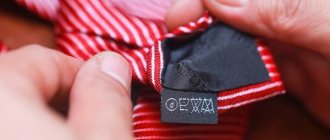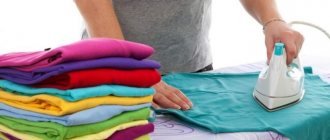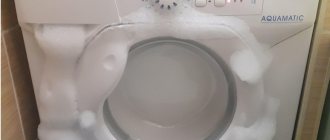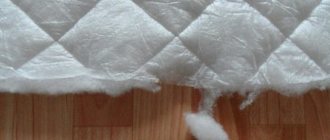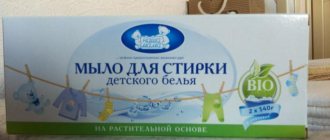Tatiana
I sew to order. I especially like to sew things from fleece: blankets, socks, sweaters. They are soft and cozy. I advise my clients to wash fleece clothing correctly so that after washing the items do not shrink or lose their softness. I share with you tips on how to wash fleece.
It is better to wash fleece by hand in warm water so that the fabric does not shrink, stretch, or deteriorate.
The history of fleece fabrics
Before the advent of fleece, people used the wool of sheep and other animals to make warm clothing. Wool also had its drawbacks, such as weight, loss of thermal properties when wet, and lack of windproof properties.
In 1979, fleece was born, a lightweight, elastic, quick-drying, breathable fabric.
But the new fabric had weaknesses: electrification, collecting dust, and the biggest one - the fabric was highly flammable (this problem does not exist now).
Fleece - what kind of fabric, description and composition
Fleece is a lightweight, warm and soft to the touch fabric. Material of artificial origin, based on polyester. During production, both primary and secondary raw materials can be used, for example, plastic bottles.
Fleece fiber has good thermal insulation, hypoallergenicity, elasticity, and hydrophobicity. In addition, fleece is a light and breathable material, and can be worn for quite a long time.
Know the density
The raw material from which fleece is made is synthetic fiber. It can be primary and secondary - for example, recycling plastic film or bottles.
Fleece fabrics vary in thickness and density:
| Microfleece Thin fabric with a thickness of less than 100 g/m. For sewing fine clothes | |
| Polarfleece Its density is slightly more than 100 g/m. Polar fleece is used to make thermal underwear, sweatshirts and leggings for sports | |
| Medium weight fleece Its density is 200 g/m. Children's clothing is made from it: hats, scarves, mittens | |
| Thick fleece The density of this material is 300 g/m. Most often, winter clothes and textiles are made from it. | |
| Ultra-thick fleece Its density is 400–600 g/m. They sew clothes for tourism and equipment |
Types of fleece
Fleece has different thicknesses, which gives it slightly different properties. The thickness of the fabric can be divided into types: micro, 100, 200, 300, 400, 600, where 600 is the thickest and least flexible.
These numbers represent the density of the material based on weight per square meter (g/m2).
Depending on the composition, fleece fabrics are called:
Cotton or cotton blend
The most commonly used fleece for sweatpants and sweatshirts, cotton or cotton-blend fleece has a smooth exterior and a soft, plush interior.
Polyester fleece
Polyester fleece products are becoming increasingly popular. Like cotton or cotton blend, polyester fleece is smooth on the outside and plush on the inside.
Polyester fleece differs from cotton fabrics in that its outer side has a shiny appearance and it does a better job of repelling moisture.
Lycra, spandex
Lycra, spandex is a blend of cotton and polyurethane elastic threads to create a stretchy fabric. It is popular for both women's clothing and teenagers.
Microfiber.
Microfiber is double-sided, thin and soft. Copes well with moisture absorption.
Mahra
Fabric covered with pile, based on loops. Tender, soft. The density depends on the size of the pile.
Textured fleece
A fabric made from two different sizes of yarn twisted together. The result is a fabric with a textured appearance.
Sherpa fleece
Sherpa is 100% polyester, very fluffy. Externally similar to natural wool (larger fibers).
Velours
Doesn't roll off over time if it's of good quality. The inside is soft and smooth, fits snugly to the body, pleasant material.
Washing a fleece blanket
It is quite difficult to wash a large product by hand, so it is wiser to entrust the operation to a home machine. But before you start washing a fleece blanket in the washing machine, you need to make sure that it fits freely in the drum.
If you have to squeeze it in with difficulty, then it’s better to abandon the idea and wash the blanket the old fashioned way - by hand.
After making sure that the item fits well in the drum, you can start washing:
- load a blanket and 2-3 tennis balls into the washing tank;
- pour in liquid detergent;
- disable spin
- activate the double (additional) rinse function;
- turn on the selected mode (delicate wash, “wool”, “synthetics”).
After finishing washing, transfer the blanket from the washing machine to the bathtub and let the water drain. Hang the wet item out to dry.
What is warmer, fleece or wool?
When comparing wool and fleece, do not forget that fleece is the second layer, which is worn, for example, on thermal underwear.
Ideal warmth can be achieved by combining a natural first layer with fleece on top.
The technical characteristics of wool and fleece are similar, but only in a dry state.
As fabrics become wet, such as from rain or sleet, fleece begins to outperform wool in terms of warmth and heat retention.
Wash by hand
If the fleece jacket/hat is clean, but there is a stain on it, it is better to soak it in cool water. Leave for 20 minutes. The stain will disappear.
If you need to wash by hand:
- Make a warm soapy solution in a basin.
- Immerse the clothes, squeeze with your hands.
- Rinse, changing the water several times.
- Do not wring things out, let the water drain.
- Dry naturally.
If you squeeze fleece too much, the clothes will wrinkle and stretch.
Fleece care
Caring for fleece items is specific, so we will dwell on this issue in more detail and look at how to wash, iron and wear fleece items.
How and at what temperature should you wash fleece?
- When it comes to washing clothes, the acceptable conditions will be indicated on the label.
- If there is no label and you are sure that the fabric is completely synthetic, you can take a piece of material sewn inside, pull out the thread and set it on fire. Natural material burns well, synthetic material will melt.
- It is advisable to wash fleece fabrics separately from natural fabrics.
- The spin cycle must be set at lower speeds (delicate) to avoid the formation of creases.
- It is necessary to wash fleece items more often than natural ones, since the washing modes are more gentle.
- The temperature at which fleece is washed varies between 40-70 degrees.
- When washing by hand, do not rub clothes too hard and do not wring them out. After washing, it is best to hang the product on hangers or a hanger and let the water drain.
- You can wash it with laundry soap and powders for synthetics, wool and silk.
And one more tip: when washing, fleece items must be turned inside out.
Does fleece shrink after washing?
It all depends on the percentage of synthetics, depending on the type of fleece fabric. If we are talking about regular fleece, then no, it does not shrink.
But after washing, you should not hang things on hot radiators or use dryers.
Can fleece be ironed?
Very often the need arises to iron clothes, which raises the question: “Is it possible to iron fleece items?”
It is better not to iron fleece, and generally not to expose it to high temperatures, or to dry it on radiators, for example. This may not cause the fabric to deteriorate, but it is quite possible that it will partially lose its thermal insulation properties.
How to wear (use) fleece?
Despite all the advantages of fleece, it is better to use it as a second layer of clothing, which is worn over thermal underwear, a T-shirt or shirt.
If you wear fleece this way, its properties will be fully revealed, namely the functions of retaining heat and removing excess moisture. In addition, based on tactile sensations, fleece is not always pleasant when worn on a naked body.
Does fleece shrink after washing?
Knitted material is made primarily from polyester. There are also varieties of fleece with a cotton backing, but they are much less common.
During the production process, the synthetic material undergoes wet heat treatment, due to which it becomes resistant to deformation. However, if the care rules are not followed, fleece can shrink greatly in size.
The main reason why a product shrinks is failure to comply with the temperature conditions when washing. If fleece is kept in too hot water, the polyester threads will shrink and the item will shrink one or more sizes.
To return the product to its original size, you need to thoroughly wet it or wash it again. Without squeezing, hang it on a rope to allow the water to drain: the weight of the jets will stretch the fabric.
What temperature is fleece rated for?
When choosing fleece, you need to know how you will use it, just wear it in everyday life or use it for sports.
The larger the structure of the fleece, the lower the temperature it is suitable for. Large pieces of lint provide better warmth in cold weather. Micro-fleece, on the contrary, warms worse, but removes evaporation from the body better.
These are the main technical characteristics of fleece; to understand at what temperature conditions it is more effective, you need to read about a specific product, look at the label or ask the seller.
After all, there are thin fleece thermal underwear, and there are jackets that are used at low temperatures from -30 to -50 degrees.
How to iron fleece items
Due to the special features of the material, the products do not require ironing. If you wash and dry things correctly, there will be no need for an iron.
If, despite your efforts, the product is wrinkled, then when ironing you should follow the recommendations:
- iron through gauze or iron;
- iron only from the wrong side;
- iron on a board covered with soft material or a terry towel;
- ironing mode – “synthetic”;
- temperature – no higher than 40-60 °C.
Despite the synthetic origin of the material, fleece items are extremely comfortable to wear. Plus, they are easy to care for: you need to remember the characteristics of knitwear and follow the washing recommendations.
Fleece for newborns, can it be used?
You can dress children and newborn babies in fleece. You just need to understand why and how to do it correctly.
Fleece is a hypoallergenic fabric; it itself does not cause irritation, itching, etc. In this regard, fleece clothing can be a good alternative for children who have some skin sensitivity to natural materials.
Secondly, fleece is a moisture-wicking garment due to its properties and porous structure. But it must be used correctly. We discussed how to wear fleece above.
Otherwise, the decision is the prerogative of the parents.
How to wash fleece items
For washing, it is better to use liquid detergents for delicate synthetic items. Conventional washing powders dissolve less well, so particles get stuck in the porous material, remaining even after thorough rinsing. As a result, the fleece becomes stiffer and becomes covered with streaks or stains.
To wash fleece items, it is better to use special products:
- Nikwax Polar Proof;
- Nikwax Base Wash;
- “Care and refreshing effect” (Perwoll);
- Micro Wash (Hey-Sport);
- Gallus Sensitive Gel.
After washing, it is recommended to use rinse aids and conditioners that have a “fleece” mark on the label. They will refresh the colors, soften the material, and prevent things from becoming electrified.
What is the difference between fleece and polar fleece?
The main difference, without getting too technical, is that polar fleece is designed for harsher temperature conditions.
Most often, polar fleece, if it is of high quality, can cost two or even three times more than regular fleece. But if there is a need for such clothes, then they are worth it, because they are much warmer.
Let's summarize:
Fleece is a modern, technically competent material. Being synthetic, it has stronger thermal and moisture-wicking properties.
The fiber is universal, suitable for all ages and activities. Fleece items, with proper care, last for quite a long time and do not cause any inconvenience.
If you liked the article, then save it to your bookmarks or share it on social networks.
And we, in turn, want to offer you high-quality children's clothing made from fleece of our production; our products, children's clothing “Duckling”, can be found on the right side of this article or in the product catalog.
The most popular sections of the site:
Other articles
Product Catalog
Wholesalers
Contacts
Handwash
Manual care usually does not take much effort and time. And if you need to wash a bulky item (a blanket, a blanket or a bulky tracksuit), then this is the only way to clean it.
Progress of the operation:
- Fill a basin or bathtub with warm water (not higher than 30-40 °C).
- Dissolve detergent.
- Soak the product for 20-60 minutes.
- Wash by hand or with a soft brush, avoiding strong pressure on the fabric: with intense rubbing movements, the fibers of the material become thinner, which affects the heat-saving properties and appearance.
- Change the water to clean water and rinse 2-3 times.
- Without squeezing, remove from the water, place on a wire rack or an inverted bowl to drain.
Advice! It is recommended to add fabric softener to the last rinse. The product will soften the fabric, prevent things from shrinking, and reduce the accumulation of static electricity.
How to soften polyester?
Some manufacturers add antistatic fibers to the fabric to solve the problem. Pure polyester is quite hard and can chafe. To soften the material, natural cotton fibers or elastane are added to it.
Interesting materials:
Is it possible to transfer money to Qiwi from Privat 24? Is it possible to transfer money from Sberbank to Yandex? Is it possible to withdraw money from Yandex wallet? Is it possible to withdraw money from a Rosselkhozbank card at Sberbank? Is it possible to withdraw money from Caspian Gold from any ATM? Is it possible to withdraw money from halva of the Republic of Belarus? Is it possible to withdraw money from a Qiwi wallet in Kazakhstan? Is it possible to withdraw money from Qiwi? Is it possible to withdraw money from money? Is it possible to withdraw money from PayPal in Ukraine?
Method 1: hand washing
| Image of stages | Instructions |
| Step 1: Removing Stains Before washing the product, remove stains and heavy soiling:
| |
| Step 2: Preparing the Detergent Dilute the gel or liquid powder in water. At what temperature is the washing and rinsing process safe for fleece items: from 30 to 40 °C. | |
| Step 3: Soak and Hand Wash Immerse the item in the detergent solution for 10 minutes and then wash it by hand. | |
| Step 4: Rinse Thoroughly rinse the solution out of the lint. Add conditioner during the final rinse. | |
| Step 5: Spin Let the water drain from the hanging item. | |
| Step 6: Drying Unfold the fleece blanket and hang it on a rope. Place the clothes on a hanger.
|
Drying rules
After washing, fleece should be hung to dry naturally:
If you wish, you can dry things by laying them out on a horizontal plane. Fleece dries very well and quickly on its own, this allows you to avoid using additional techniques to speed up the drying process.
Don't use:
Conclusion
Now that you know how to wash textured fleece material, you can preserve its properties and enjoy the softness and freshness of your items. The video in this article will help you and provide you with recommendations. Ask your questions in the comments if you need to clarify any nuances.
Fleece is a unique fabric in terms of softness, which many people mistakenly mistake for natural. For this reason, housewives begin to wash fleece items incorrectly, causing the fibers to thin. The material ceases to retain heat, and the functional properties of the item gradually drop to zero.
Like any synthetics, fleece reacts negatively to aggressive detergents, high temperatures and professional stain removers. But even at home, it is possible to provide the fabric with complete care, ensuring that the product is maintained in optimal condition.
Suitable detergents
Fleece is a synthetic knitted material made from polyester. It is a wool substitute and is not as demanding on detergents as natural material:
| Photo | Characteristics |
| Remedy 1. Liquid gels and powders. Synthetic fibers are easily cleaned with liquid products. Ordinary powders are difficult to wash out of dense fleecy fabric. | |
| Remedy 2. Laundry soap. To get rid of stains, use 72% soap. It is effective for heavy soiling. It is enough to rub the stain with soap and wash it under running water after 5 minutes. This fabric is easy to wash.
| |
| Remedy 3. Conditioner. Add conditioner during the final rinse to soften the fluff and remove static electricity. Fleece items are subject to electrification. |

